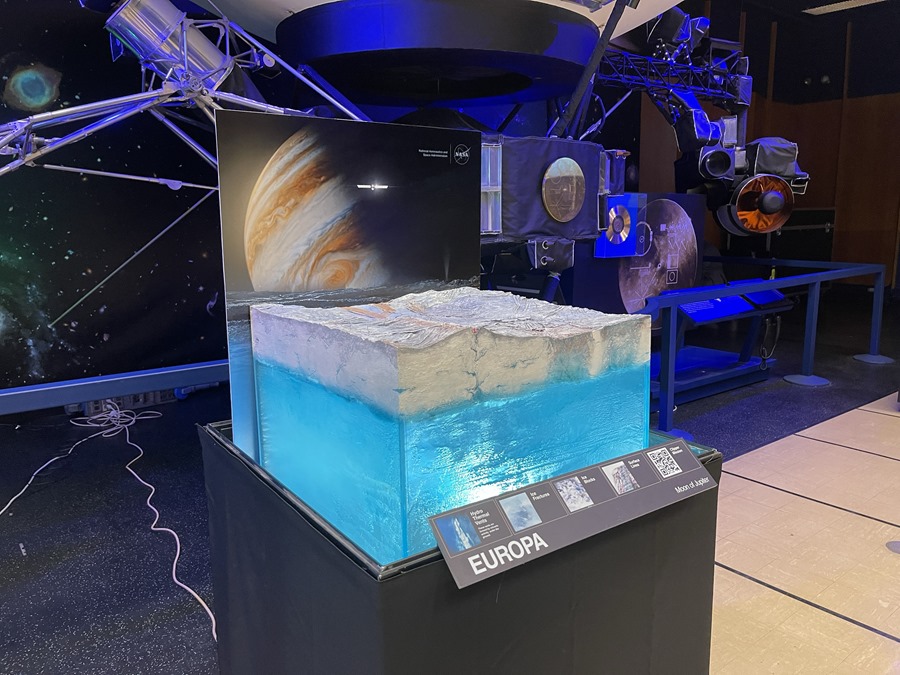Europa Clipper finalizes details of its historic journey to Jupiter’s icy moon

Ana Milena Varon |
Los Angeles (USA) (EFE). – Europa Clipper, the largest spacecraft ever built by NASA for a planetary mission, is completing operational tests to begin its historic journey to Europa, Jupiter’s icy moon, and its home in October. It is believed that “all the elements to support life are present here.”
The spacecraft, 5 meters tall and 30.5 meters wide, will explore in detail Europa, one of Jupiter’s most famous moons, which is covered in a thick layer of ice and has an internal ocean twice the size of all Earth’s oceans.
“What we are interested in is knowing whether there is a possibility of a certain type of life (on Jupiter’s moon),” Tim Larson, deputy director of the Europa Clipper project at NASA’s Jet Propulsion Laboratory, told EFE.
This laboratory, located in Pasadena, California, gave EFE access to the “clean room” where the Europa Clipper is located, which must be entered in special clothing, without any lotion or makeup, so as not to contaminate the ship. , which looks like a Hollywood set.
Europa is believed to contain three elements: liquid water, essential chemicals, and a source of energy needed to develop and sustain life.
Larson cautions that while Europa Clipper is not a life-detection mission per se, understanding the habitability of Jupiter’s moon will help better understand how life evolved on Earth and the potential to find it beyond our planet.

The Long Road to Jupiter
The mission, which began in 2013, was joined by dozens of scientists working on its development and noted that the ship had recently passed design tests; and is ready for delivery in May to the Kennedy Space Center in central Florida, where it will be completed.
Equipped with nine powerful scientific instruments, Europa Clipper is scheduled to launch on a SpaceX Falcon Heavy rocket on October 10.
NASA estimates it will take the spacecraft at least five and a half years to travel 2.9 billion kilometers to reach Jupiter, and another year to adjust its orbit and begin exploration in 2030.

Space engineer Ricardo Restrepo, who is part of the team that developed the ship’s route, explained to EFE that it will orbit Jupiter and “periodically fly over Europa” to obtain data that it will send back to Earth a few days later, while it uses advantage for charging solar panels.
The mission is expected to make 50 flybys of Jupiter’s moon over a four-year period.
I do not exclude that the ship will be able to expand its research, as happened with the Galileo mission, which explored the frozen surface of Europa more than 20 years ago.
Restrepo is confident that the Europa Clipper will achieve its goal because it is highly functional and resistant to radiation. “This is the most complex, the most expensive and the largest ever built,” he emphasizes.
Portal to life

Expectations for the mission relate not only to the scientific discoveries that can be achieved, but also to its significance for humanity. “For the first time as humans, we are going to look for life beyond Earth,” says Restrepo, who is of Colombian descent.
That’s why Europa Clipper will carry a message on a plaque engraved on both sides, which includes the poem “In Praise of Mystery: A Poem for Europe” by award-winning Mexican-born writer Ada Limón, which encourages understanding and exploration. the mysteries of the Earth that unite against the vastness of the Universe.
It also contains visual representations of the sound waves produced by the word “water” in 103 languages, combining indigenous languages and sign language.
It will also feature a “bottle” with the names of more than two million people who have joined the campaign to honor the mission.
“This ship will not represent NASA or a few engineers, but humanity itself,” notes Restrepo.